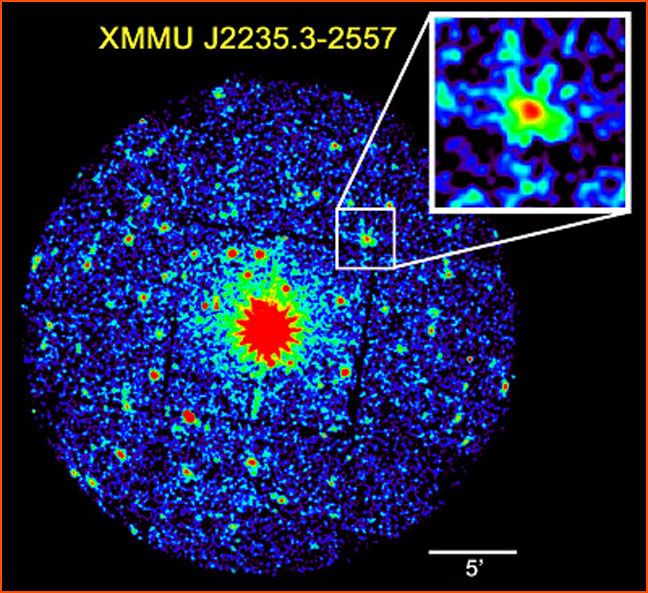
home •
about •
essential guide •
picture of the day •
thunderblogs •
news •
multimedia •
predictions •
products •
get involved •
contact
picture of the day archive subject index
Credit: ESA XMM-Newton
Aug 06, 2007
So Far and Yet So NearOne more problem for the Big Bang: Recently-discovered galaxy clusters reveal too much complex structure to be as “young” as Big Bang speculations would require.
The small inset in the photo above shows a recently discovered cluster of galaxies that poses a big problem for the Big Bang.
According to conventional theory, which determines the distance of a galaxy by its redshift, the cluster is 9 billion light years away. That means the light we see today was emitted 9 billion years ago, or only 5 billion years after the Big Bang, in which all matter and energy supposedly was created. Gravitational forces could not have generated such a cluster of galaxies in such an astronomically short time.
The ESO news release commented:
"The discovery of such a complex and mature structure so early in the history of the Universe is highly surprising. Indeed, until recently it would even have been deemed impossible."
Translation: This observation falsified the theory. To save the theory (upon which grants and reputations are established) an ad hoc patch must be found.
“If astronomy were a science”—as one worker in the field put it—astronomers would have wondered if the cluster might have been ejected from the nearby active galaxy NGC 7314 (at the center of the large image). They would have wondered if its high redshift might be due to that ejection instead of to an expansion of the universe. They would have wondered if the cluster might be an early stage of galaxy cluster formation in the near present instead of in the far past.
But such wondering would require them to doubt that redshift means distance. It would require them to doubt that redshift means recessional velocity. And if redshift does not mean distance or velocity, then the two major pillars of Big Bang theory are undermined.
On the other hand, because this cluster is in the halo of the active galaxy NGC 7314, this observation once again confirms Halton Arp’s prediction that high-redshift galaxy clusters will be found in association with low-redshift active galaxies. Arp made this prediction many times. In a paper on galaxy clusters, written in collaboration with amateur astronomer David G. Russell and published in the Astrophysical Journal of March 10, 2001, Arp and Russell add more than 15 new cluster/active galaxy associations to the list Arp has been gathering for three decades.
We can carry this prediction one step further. We can predict that other complex galaxy clusters with high redshifts (perhaps even higher than this one) will be discovered in the future. And we can also predict that they will be found close to nearby active galaxies. Some of them may even be found between their active parent galaxy and us.
The really big problem is not the discrepancy between Big Bang theory and contrary observations but the singularity of belief that compels astronomers to turn a blind eye to the wrong end of their telescopes while ignoring disagreements with what they imagine they see
___________________________________________________________________________Please visit our Forum
The Electric Sky and The Electric Universe available now!

|
|

|
EXECUTIVE EDITORS:
David Talbott, Wallace Thornhill
MANAGING EDITORS:
Steve Smith, Mel Acheson
CONTRIBUTING EDITORS: Michael Armstrong, Dwardu Cardona,
Ev Cochrane,
C.J. Ransom, Don Scott, Rens van der Sluijs, Ian Tresman
WEBMASTER: Brian Talbott
Copyright 2007: thunderbolts.info
![]()
home •
thunderblogs •
forum •
picture of the day •
resources •
team •
updates •
contact us

